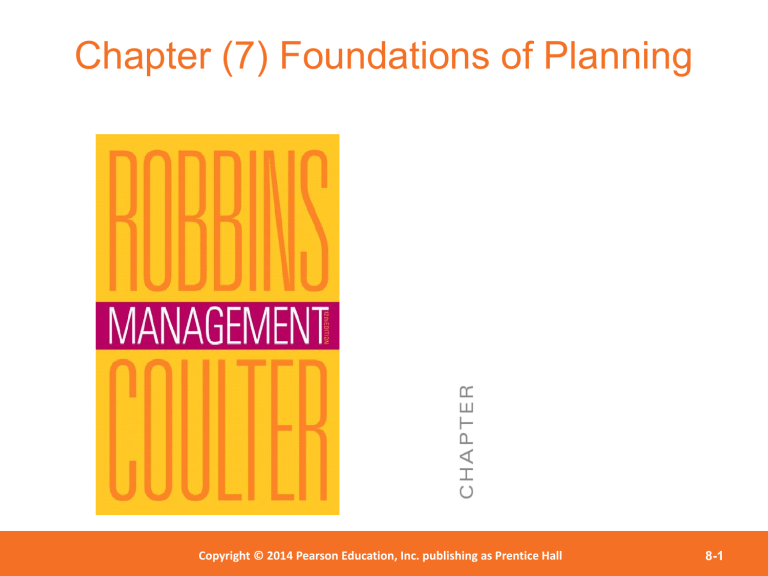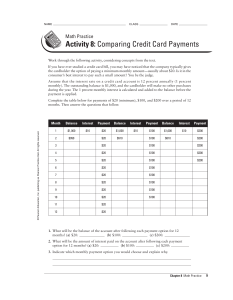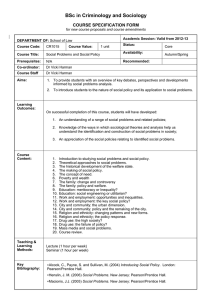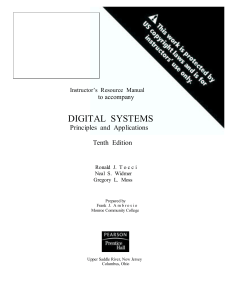
Chapter (7) Foundations of Planning Copyright 2012 Pearson Education, Copyright © 2014 Pearson©Education, Inc. publishing as Prentice Hall Inc. Publishing as Prentice Hall 8-1 Define the nature and purposes of planning. Classify the types of goals organizations might have and the plans they use. Compare and contrast approaches to goalsetting and planning. Discuss contemporary issues in planning. Copyright © Education, 2012 Pearson Copyright © 2014 Pearson Inc.Education, publishingInc. as Prentice Hall Publishing as Prentice Hall 8-2 What Is Planning? • Planning - defining the organization’s goals, establishing strategies for achieving those goals, and developing plans to integrate and coordinate work activities. • Formal planning – Specific goals covering a specific time period – These goals are: Written and shared with organizational members. – Specific plans exist for achieving these goals. Copyright 2012 Pearson Education, Copyright © 2014 Pearson©Education, Inc. publishing as Prentice Hall Inc. Publishing as Prentice Hall 8-3 Why Do Managers Plan? • Four reasons for planning – Provides direction – Reduces uncertainty – Minimizes waste and redundancy – Sets the standards for controlling Copyright 2012 Pearson Education, Copyright © 2014 Pearson©Education, Inc. publishing as Prentice Hall Inc. Publishing as Prentice Hall 8-4 Planning and Performance • Formal planning is associated with: – Positive financial results - higher profits, higher return on assets, and so forth – The quality of planning and implementation affects performance more than the extent of planning – The external environment can reduce the impact of planning on performance – The planning-performance relationship seems to be influenced by the planning time frame Copyright 2012 Pearson Education, Copyright © 2014 Pearson©Education, Inc. publishing as Prentice Hall Inc. Publishing as Prentice Hall 8-5 Goals and Plans • Goals (objectives) - desired outcomes or targets • Plans - documents that outline how goals are going to be met Copyright 2012 Pearson Education, Copyright © 2014 Pearson©Education, Inc. publishing as Prentice Hall Inc. Publishing as Prentice Hall 8-6 Types of Plans • The most popular ways to describe organizational plans are breadth (strategic versus operational), time frame (short term versus long term), specificity (directional versus specific), and frequency of use (single use versus standing). • As Exhibit 7-1 shows page 163 Copyright 2012 Pearson Education, Copyright © 2014 Pearson©Education, Inc. publishing as Prentice Hall Inc. Publishing as Prentice Hall 8-7 Exhibit 7-1 Types of Plans Copyright 2012 Pearson Education, Copyright © 2014 Pearson©Education, Inc. publishing as Prentice Hall Inc. Publishing as Prentice Hall 8-8 Types of Plans • Strategic plans - plans that apply to the entire organization and establish the organization’s overall goals • Operational plans - plans that encompass a particular operational area of the organization Copyright 2012 Pearson Education, Copyright © 2014 Pearson©Education, Inc. publishing as Prentice Hall Inc. Publishing as Prentice Hall 8-9 Types of Plans (cont.) • Long-term plans - plans with a time frame beyond three years • Short-term plans - plans covering one year or less • Specific plans – plans that are clearly defined and leave no room for interpretation • Directional plans - plans that are flexible and set out general guidelines Copyright 2012 Pearson Education, Copyright © 2014 Pearson©Education, Inc. publishing as Prentice Hall Inc. Publishing as Prentice Hall 8-10 Types of Plans (cont.) • Single-use plan - a one-time plan specifically designed to meet the needs of a unique situation • Standing plans ongoing plans that provide guidance for activities performed repeatedly Copyright 2012 Pearson Education, Copyright © 2014 Pearson©Education, Inc. publishing as Prentice Hall Inc. Publishing as Prentice Hall 8-11 Approaches to Setting Goals and developing plans: a) Traditional goal-setting - an approach to setting goals in which top managers set goals then flow down through the organization and become subgoals for each organizational area • Means-ends chain - an integrated network of goals in which the accomplishment of goals at one level serves as the means for achieving the goals, or ends, at the next level Copyright 2012 Pearson Education, Copyright © 2014 Pearson©Education, Inc. publishing as Prentice Hall Inc. Publishing as Prentice Hall 8-12 • A problem with traditional goal-setting is that when top managers define the organization’s goals in broad terms—such as achieving “sufficient” profits or increasing “market leadership”—these ambiguous goals have to be made more specific as they flow down through the organization. Managers at each level define the goals and apply their own interpretations and biases as they make them more specific. • However, what often happens is that clarity is lost as the goals make their way down from the top of the organization to lower levels. Exhibit 7-2 page 165 illustrates what can happen. Copyright 2012 Pearson Education, Copyright © 2014 Pearson©Education, Inc. publishing as Prentice Hall Inc. Publishing as Prentice Hall 8-13 Exhibit 7-2 The Downside of Traditional Goal-Setting Copyright 2012 Pearson Education, Copyright © 2014 Pearson©Education, Inc. publishing as Prentice Hall Inc. Publishing as Prentice Hall 8-14 Approaches to Setting Goals (cont.) b) Management by objectives (MBO) a process of setting mutually agreed upon goals and using those goals to evaluate employee performance Copyright 2012 Pearson Education, Copyright © 2014 Pearson©Education, Inc. publishing as Prentice Hall Inc. Publishing as Prentice Hall 8-15 • MBO programs have four elements: goal specificity, participative decision making, an explicit time period, and performance feedback. • Instead of using goals to make sure employees are doing what they’re supposed to be doing, MBO uses goals to motivate them as well. The appeal is that it focuses on employees working to accomplish goals they’ve had a hand in setting. Copyright 2012 Pearson Education, Copyright © 2014 Pearson©Education, Inc. publishing as Prentice Hall Inc. Publishing as Prentice Hall 8-16 Exhibit 7-3 Steps in MBO Copyright 2012 Pearson Education, Copyright © 2014 Pearson©Education, Inc. publishing as Prentice Hall Inc. Publishing as Prentice Hall 8-17 What is Strategic Planning? • Strategic Planning determines where an organization is going over the next year or more, how it is going to get there and how it will know if it achieved its goals. • Strategic planning serves a variety of purposes in organization, including to: – Clearly define the purpose of the organization and to establish realistic goals and objectives consistent with that mission in a defined time frame within the organization’s capacity for implementation. – Communicate those goals and objectives to the organization’s constituents. – Develop a sense of ownership of the plan. – Ensure the most effective use is made of the organization’s resources by focusing the resources on the key priorities. – Provide a base from which progress can be measured and establish a mechanism for informed change when needed. – Bring together of everyone’s best and most reasoned efforts have important value in building a consensus about where an organization is going. – Provides clearer focus of organization, producing more efficiency and effectiveness – Bridges staff and board of directors (in the case of corporations) – Builds strong teams in the board and the staff (in the case of corporations) – Provides the glue that keeps the board together (in the case of corporations) – Produces great satisfaction among planners around a common vision – Increases productivity from increased efficiency and effectiveness – Solves major problems Vision, Mission & Values • Developing a Vision Statement – The vision statement includes vivid description of the organization as it effectively carries out its operations. – Developing the vision can be the most enjoyable part of planning, but the part where time easily gets away from you. – the vision has become more of a motivational tool, too often including highly idealistic phrasing and activities which the organization cannot realistically aspire. • Developing a Mission Statement – The mission statement describes the overall purpose of the organization. – When wording the mission statement, consider the organization's products, services, markets, values, and concern for public image, and maybe priorities of activities for survival. – Consider any changes that may be needed in wording of the mission statement because of any new suggested strategies during a recent strategic planning process. – Ensure that wording of the mission is to the extent that management and employees can infer some order of priorities in how products and services are delivered. – When refining the mission, a useful exercise is to add or delete a word from the mission to realize the change in scope of the mission statement and assess how concise is its wording. – Does the mission statement include sufficient description that the statement clearly separates the mission of the organization from other organizations? • Developing a Values Statement – Values represent the core priorities in the organization’s culture, including what drives members’ priorities and how they truly act in the organization, etc. Values are increasingly important in strategic planning. – Establish four to six core values from which the organization would like to operate. Consider values of customers, shareholders, employees and the community. SWOT Analysis Strengths Weaknesses - internal to entity -Resources and capabilities that can be used to develop a competitive advantage - Internal to entity - Absence of certain strengths Opportunities Threats - External to entity - External analysis may reveal new opportunities for growth - External to entity - Changes in the environment that present a threat or loss






